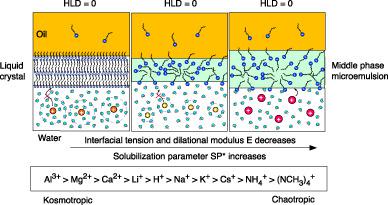当前位置:
X-MOL 学术
›
J. Surfactants Deterg.
›
论文详情
Our official English website, www.x-mol.net, welcomes your
feedback! (Note: you will need to create a separate account there.)
How the Influence of Different Salts on Interfacial Properties of Surfactant–Oil–Water Systems at Optimum Formulation Matches the Hofmeister Series Ranking
Journal of Surfactants and Detergents ( IF 1.6 ) Pub Date : 2020-03-15 , DOI: 10.1002/jsde.12406 Ramon E. Vera 1 , Franklin Salazar‐Rodríguez 1 , Ronald Marquez 1 , Ana M. Forgiarini 1
Journal of Surfactants and Detergents ( IF 1.6 ) Pub Date : 2020-03-15 , DOI: 10.1002/jsde.12406 Ramon E. Vera 1 , Franklin Salazar‐Rodríguez 1 , Ronald Marquez 1 , Ana M. Forgiarini 1
Affiliation

|
In this work, we present the effects of salts on sodium dodecyl benzene sulfonate micellization and on the interfacial performance of a sodium dodecyl benzene sulfonate–heptane–brine system at optimum formulation, i.e., hydrophilic–lipophilic deviation (HLD) = 0. In order to do that, interfacial tension and dilational interfacial rheology properties of surfactant–heptane–water systems at optimum formulation are measured using an interfacial spinning drop tensiometer with an oscillating velocity, which can accurately measure interfacial rheology properties at both low and ultralow interfacial tensions. The brines used contain one of the following salts: MgCl2, CaCl2, NaCl, NH4Cl, NaNO3, CH3COONa, or Na2SO4. We performed a one‐dimensional salinity scan with each of these salts to achieve an optimum formulation. In relation to the Hofmeister series, we found that, at optimum formulation, systems with chaotropic ions (NH4+, NO3−) present interfaces with ultralow interfacial tensions, very low dilational modulus, and a low phase angle, whereas kosmotropic ions (Mg2+, Ca2+, SO4−2) generate high interfacial tension and high rigidity monolayers. Intermediate ions in the Hofmeister series (Na+, CH3COO−, Cl−) present interfaces with intermediate properties. Furthermore, according to the Hofmeister series, interfaces can be respectively ordered from higher to lower rigidity for surfactant counterions Mg2+ > Ca2+ > Na+ > NH4+ and coions SO42− > CH3COO– > Cl− > NO3−, which correspond to a salting‐out (highest rigidity) and salting‐in (lowest rigidity) effect. We observed that counterions have a more significant effect on surfactant–oil–water system properties than those that act as coions.
中文翻译:

最佳配方下不同盐对表面活性剂-油-水系统界面性质的影响如何与Hofmeister系列排名匹配
在这项工作中,我们介绍了盐在最佳配方下对十二烷基苯磺酸钠-庚烷-盐水体系的胶束化和界面性能的影响,即亲水-亲脂性偏差(HLD)= 0。要做到这一点,可以使用具有振荡速度的界面旋转液滴张力计来测量最佳配方下的表面活性剂-庚烷-水系统的界面张力和膨胀界面流变性能,该界面张力仪可以在低和超低界面张力下准确地测量界面流变性能。使用的盐水包含以下盐之一:MgCl 2,CaCl 2,NaCl,NH 4 Cl,NaNO 3,CH 3 COONa或Na2 SO 4。我们对每种盐进行了一维盐度扫描,以获得最佳配方。相对于霍夫迈斯特系列中,我们发现,在最佳配方,用离液序列高的离子(NH系统4 +,NO 3 - )具有超低界面张力,非常低的扩张模量和低的相位角本的接口,而离液序列低的离子( Mg 2 +,Ca 2 +,SO 4 -2)产生高界面张力和高刚性单层。在霍夫迈斯特系列中间离子(Na +,CH 3 COO - ,氯-)呈现具有中间属性的界面。此外,根据霍夫迈斯特系列,接口可以分别从较高的有序为较低的表面活性剂的刚性抗衡的Mg 2+ >的Ca 2+ >的Na + > NH 4个+和coions SO 4 2- > CH 3 COO - >氯- > NO 3 - ,其对应于盐析(最高刚性)和盐溶(最低刚性)的效果。我们观察到,抗衡离子对表面活性剂-油-水系统特性的影响要比充当离子的那些更为重要。
更新日期:2020-03-15
中文翻译:

最佳配方下不同盐对表面活性剂-油-水系统界面性质的影响如何与Hofmeister系列排名匹配
在这项工作中,我们介绍了盐在最佳配方下对十二烷基苯磺酸钠-庚烷-盐水体系的胶束化和界面性能的影响,即亲水-亲脂性偏差(HLD)= 0。要做到这一点,可以使用具有振荡速度的界面旋转液滴张力计来测量最佳配方下的表面活性剂-庚烷-水系统的界面张力和膨胀界面流变性能,该界面张力仪可以在低和超低界面张力下准确地测量界面流变性能。使用的盐水包含以下盐之一:MgCl 2,CaCl 2,NaCl,NH 4 Cl,NaNO 3,CH 3 COONa或Na2 SO 4。我们对每种盐进行了一维盐度扫描,以获得最佳配方。相对于霍夫迈斯特系列中,我们发现,在最佳配方,用离液序列高的离子(NH系统4 +,NO 3 - )具有超低界面张力,非常低的扩张模量和低的相位角本的接口,而离液序列低的离子( Mg 2 +,Ca 2 +,SO 4 -2)产生高界面张力和高刚性单层。在霍夫迈斯特系列中间离子(Na +,CH 3 COO - ,氯-)呈现具有中间属性的界面。此外,根据霍夫迈斯特系列,接口可以分别从较高的有序为较低的表面活性剂的刚性抗衡的Mg 2+ >的Ca 2+ >的Na + > NH 4个+和coions SO 4 2- > CH 3 COO - >氯- > NO 3 - ,其对应于盐析(最高刚性)和盐溶(最低刚性)的效果。我们观察到,抗衡离子对表面活性剂-油-水系统特性的影响要比充当离子的那些更为重要。











































 京公网安备 11010802027423号
京公网安备 11010802027423号